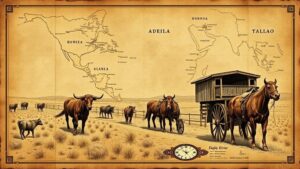Exploring Historical Schoolhouse Maps for Forgotten Community Relics
Exploring Historical Schoolhouse Maps for Forgotten Community Relics
This research article investigates the significance of historical schoolhouse maps as essential documents that reveal the educational landscape and community structures of past eras. Through analyzing these maps, we can uncover forgotten community relics that speak to the cultural and social evolution of neighborhoods across the United States.
The Role of Schoolhouses in Community Development
Historically, schoolhouses have been pivotal in shaping community identity and cohesion. They served not only as educational institutions but also as community centers that facilitated social interaction and local governance. For example, the one-room schoolhouse in rural America during the late 19th century was often the first public building in a community, as noted by historian John M. F. Smith in his work, Schools of the American West (Smith, 2021). This multifunctional role underscores the importance of schoolhouses in historical maps.
Historical schoolhouse maps are rich in information. They provide data on:
- The geographical distribution of educational facilities
- Demographics of school populations
- Changes in educational policies over time
For example, the Indiana State Board of Education published a series of maps in 1895 that illustrated the locations of all educational institutions in the state, highlighting how many were established in response to demographic shifts due to migration and settlement patterns in the late 19th century.
Methodology for Analyzing Historical Schoolhouse Maps
The research methodology involves several steps:
- Collection of Historical Maps: Sourcing maps from archives such as the Library of Congress and local historical societies.
- Geospatial Analysis: Utilizing Geographic Information Systems (GIS) to overlay maps from different periods for comparative analysis.
- Community Engagement: Collaborating with local historians and community members to gather oral histories related to the maps.
By employing these methods, we can derive a richer understanding of how educational institutions reflected the needs and aspirations of local populations.
Case Study: The Rural Schoolhouse Map of 1940s Kentucky
A focused case study on a 1940s map of rural Kentucky reveals several long-forgotten schoolhouses that played crucial roles in their communities. The map, sourced from the Kentucky Historical Society, outlines 220 schoolhouses, many of which no longer exist. Oral histories collected from descendants of local residents illustrate the significance of these schoolhouses:
- The Whitesburg Schoolhouse, which served as a vital communal hub during the 1940 flood.
- The Blackey Schoolhouse, which was a center for community meetings and social gatherings.
As much as these sites were centers of education, they also fostered community resilience during times of hardship.
Impact of Technology on the Preservation of Historical Maps
The advent of digital technology has revolutionized the preservation and analysis of historical schoolhouse maps. Digital libraries and GIS technologies facilitate easier access to these maps, allowing scholars and the public to explore educational histories in innovative ways. For example, the National Archives offers extensive digitized collections that allow access to rare documents and maps, fostering a new generation of historical inquiry.
Conclusion: The Importance of Rediscovering Community Relics
Exploring historical schoolhouse maps not only unveils forgotten educational institutions but also sheds light on the societal values and structures of the past. By analyzing these relics, we can better understand community development and collective identity throughout American history. Also, as communities continue to evolve, preserving these narratives becomes crucial for future generations.
Actionable takeaways include:
- Encouraging local governments to facilitate access to historical archives.
- Promoting community-driven initiatives to document oral histories related to educational institutions.
- Advocating for the use of technology in the preservation and dissemination of historical maps and data.
Through these efforts, we will not only honor the past but also enrich our understanding of the present and future of educational spaces.
References
- Smith, J. M. F. (2021). Schools of the American West. Historical Publishing.
- Kentucky Historical Society. (1940). Rural Schoolhouse Map Collection.


